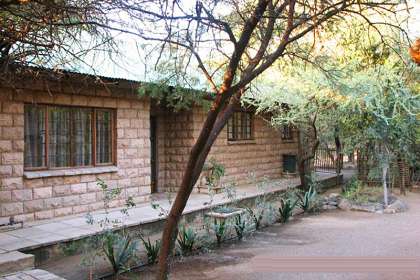Tswaing Meteorite Crater Museum
The Tswaing Meteorite Crater was formed about 220 000 years ago when a large stony meteorite crashed into the earth's crust. This formed a 1.4 km impact crater, nearly 200 m deep in an area about 40 km northwest of Pretoria . On a geological time scale, this impact is actually quite recent. This explains why it is best-preserved meteorite impact craters in the world.
The saline lake formed by the meteorite crater has attracted humans ever since it was formed. White settlers named the region Zoutpan (Salt Pan). Local Tswana tribes call the region ""Tswaing"" or ""Place of Salt"".
The Early Stone Age people that occupied the Magaliesberg region at the time would have witnessed an incredible explosion. The meteorite itself was probably about 30-50m across with an impact velocity of nearly 100,000 km/hr, which would have created a 20-40 Megaton explosion - the equivalent of 1,000 Hiroshima nuclear bombs. The resulting blast wave would have flattened trees for at least a 20 km radius.
The site is now administered by the National Cultural History Museum, who are undertaking several developments including:
- an environmental education centre
- a community arts and cultural centre
- eradication of invasive vegetation
- a breeding herd of Nguni cattle
- the 7 km Tswaing Crater Trail
DIRECTIONS:
- from Pretoria West, follow the R81 north to Mabopane
- turn right to the R35 and continue north for 14 km
HOURS:
07:30 - 16:00 daily
The saline lake formed by the meteorite crater has attracted humans ever since it was formed. White settlers named the region Zoutpan (Salt Pan). Local Tswana tribes call the region ""Tswaing"" or ""Place of Salt"".
The Early Stone Age people that occupied the Magaliesberg region at the time would have witnessed an incredible explosion. The meteorite itself was probably about 30-50m across with an impact velocity of nearly 100,000 km/hr, which would have created a 20-40 Megaton explosion - the equivalent of 1,000 Hiroshima nuclear bombs. The resulting blast wave would have flattened trees for at least a 20 km radius.
The site is now administered by the National Cultural History Museum, who are undertaking several developments including:
- an environmental education centre
- a community arts and cultural centre
- eradication of invasive vegetation
- a breeding herd of Nguni cattle
- the 7 km Tswaing Crater Trail
DIRECTIONS:
- from Pretoria West, follow the R81 north to Mabopane
- turn right to the R35 and continue north for 14 km
HOURS:
07:30 - 16:00 daily
Accommodation Near Tswaing Meteorite Crater Museum
Showing 1 to 1 of 1 results
Little Bushveld
Self Catering House, Cottage, Chalet Accommodation in Bon Accord
25.2km from Tswaing Meteorite Crater MuseumLittle Bushveld offers self catering accommodation in Bon Accord near Pretoria North in Pretoria / Tshwane. We offer 6 chalets ranging from a 2 sleeper to 7 sleeper. These very private self catering chalets on a smallholding are ideal for a real "Slow-Lif …see more for bookings / enquiries and info.
Showing 1 to {{total}} of {{total}} results
No results
Nearby Towns
© WhereToStay.co.za 1998-2024
Tswaing Meteorite Crater Museum Information | WhereToStay.co.za
WTS App Browser


